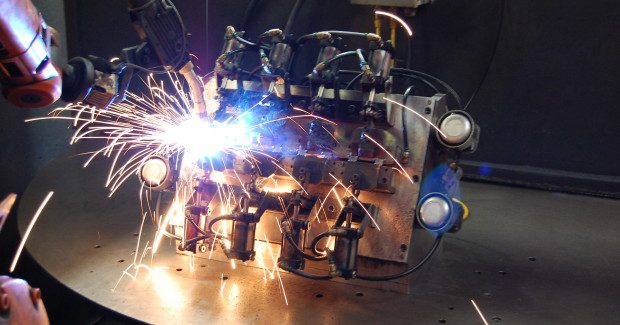THE ANSI / AWS WAY TO A SAFE WELDING WORKPLACE
U.S. welding engineers that use industrial arc welding robots can choose from a number of available voluntary industry standards to provide guidance on the subject of robot system safeguard selection. However, differences exist between a highly subjective matrix style of risk assessment and a more focused and structured risk assessment such as the AWS Protocol Method. Here are some reasons why the selection of proper safeguards should be a straightforward process that provides consistent results.
Posted: September 30, 2013
Engineers in American factories that employ industrial arc welding robots can choose from a number of available voluntary industry standards to provide guidance on the subject of robot system safeguard selection. The American Welding Society (Miami, FL) has developed a suite of ANSI approved safety and equipment standards that provide comprehensive guidance to engineers who are responsible for the design, manufacture and use of robot welding systems.
These documents are developed by the AWS D16 committee that was formed in 1985. Since 1991 the D16 committee has developed four ANSI standards:
- — D16.1 Specification for Arc Welding Safety
- — D16.2 Guide for Components of Robotic and Automatic Arc Welding Installations
- — D16.3 Risk Assessment Guide for Robot Arc Welding
- — D16.4 Specification for the Qualification of Robot Arc Welding Personnel
ANSI standards are peer-reviewed consensus documents that are considered voluntary for use by American industry. The leading international standards development body is the International Standards Organization, based in Geneva Switzerland. ISO standards are also considered to be voluntary in nature.
http://youtu.be/BuWsMEs14E0
This Fanuc ArcMate 120iB/10L welding robot has a state-of-the-art safety environment with two sets of light curtains, zone ring, and pneumatic sliding arc glare curtains to protect the operator from welding flash.
In the U.S., industrial safety is the principal concern of the Occupational Safety and Health Administration (Washington, DC). This federal organization promulgates safety rules that are codified in the Code of Federal Regulations. OSHA regulations are not industry-voluntary in nature. OSHA regulations carry the force of law and OSHA is empowered to enforce the regulations as required by law.
Currently welding engineers have four general purpose robot safety standards to choose from in the U.S.: ANSI/AWS D16.1, ANSI/UL 1740, ANSI/RIA R15.06 and ISO 10218. The UL and the AWS standards acknowledge OSHA and include requirements that are uniquely tailored to the needs of the American market. The newly released R15.06 standard is an adoption of the ISO 10218 standard. The adopted standard is a direct adoption by RIA. Only minor grammar and syntax changes were made by RIA to account for the difference between American English and English translations.
The difference between the ISO industrial safety standards and standards produced by American organizations such as AWS can be traced to one principle premise: the U.S. legal system is the most unique in the world and on matters of labor law the US government considers the employer to be ultimately responsible for the health and safety of industrial employees. This position is evidenced by the OSHA General Duty Clause, CFR 29 1910 which states in part:
(a) Each employer — (1) shall furnish to each of his employees employment and a place of employment which are free from recognized hazards that are causing or are likely to cause death or serious physical harm to his employees. “The employer (re: user) is responsible.”
This position is in direct contrast with the position taken by ISO. The term ‘User’ is synonymous in this context with the term employer. The ISO 10218 standard does not provide user requirements because in the ISO system users are not recognized. The recognized parties are equipment suppliers and employees.
For most of the rest of the world employers are indemnified from legal action that could plausibly arise from an injury accident event. Claims for relief brought by an injured employee are difficult to pursue because of the loser pays rules that are in place throughout the ISO community, with the exception of the U.S. To make matters worse for injured employees is the fact that the open and unfettered use of the trial by jury of peer’s process is not recognized in courts outside of the U.S.
For this reason the ISO standards are not helpful to U.S. welding engineers because they do not address the user requirements and they do not recognize the primacy of OSHA. The ISO standards not only exclude OSHA from consideration but they do not reference any American standards published by ANSI or any other U.S. standards body.
TECHNICAL STANDARDS AND SAFETY STANDARDS
There is no question that in a global marketplace there is a critical need for international technical standards. International commerce would grind to a halt if no technical standards existed. From mundane products such as electrical connectors to the sophisticated navigation systems used in jet airliners voluntary industry standards are required.
The same is not true for safety standards. The distinction between technical and safety standards is clear and unambiguous. For American companies and any company that establishes manufacturing facilities that geographically fall under the jurisdiction of OSHA the voluntary standards employed should include user requirements and should recognize ANSI standards.
One clause that is common to virtually all voluntary industry consensus standards is the Normative Reference Clause. As a means of shorthand the clause was developed so that ancillary standards that include critical requirements are not duplicated verbatim in the text of the document. The documents can be cited as requirements to a standard and they are identified by their standard document designation.











